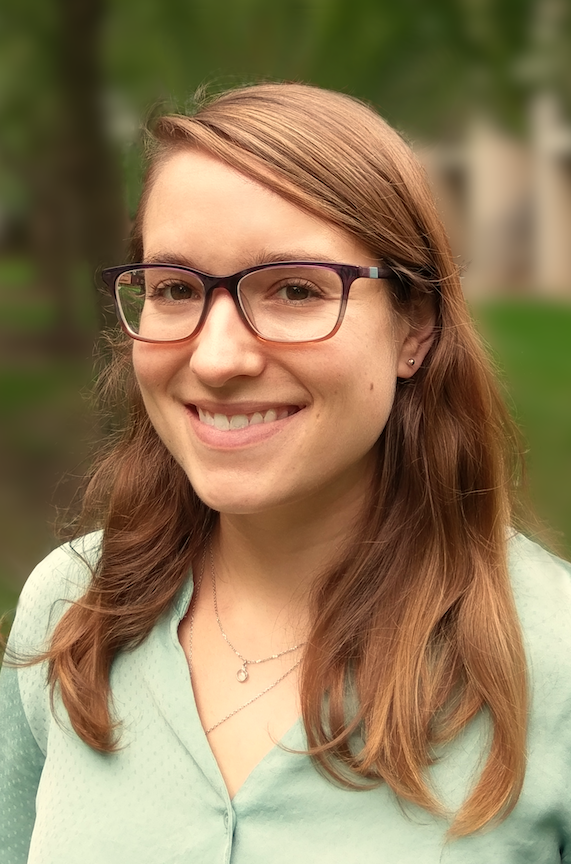Katharine Diehl
Assistant Professor of Medicinal Chemistry
Chromatin and Histone Modifications, Epigenetics and Metabolism, Protein Chemistry, Metabolite Sensors

Biological Chemistry Program
Molecular Biology Program
Education
B.S. University of North Carolina at Chapel Hill
Ph.D. University of Texas at Austin
Research
The eukaryotic genome is regulated by a variety of epigenetic mechanisms that establish and maintain proper gene expression profiles to control cell identity and fate. One of these vital mechanisms is accomplished by chromatin, which is the packaging medium for genomic DNA. The chromatin polymer consists of individual nucleosomes in which the DNA is wrapped around an octamer of the canonical histone proteins H2A, H2B, H3, and H4. The histone proteins are highly post-translationally modified, and these modifications (PTMs) have an impact on the local chromatin environment through both direct biophysical perturbations and recruitment of downstream effectors. Different PTM chemotypes (e.g., methylation, acetylation, ADP-ribosylation) at different sites within the histones act as dynamic signals to delineate specific chromatin states. Thus, far from being a passive scaffold for the genome, chromatin actively controls access to the underlying genetic material to aid in regulating transcription, translation, and repair. Importantly, when histone PTMs and other epigenetic factors are disrupted, these processes are misregulated leading to diseases such as cancer and developmental disorders.
Our lab studies how the deposition, removal, and recognition of these histone PTMs are regulated and what downstream effects these PTMs have on DNA-mediated processes. In particular, our focus is studying how metabolism is linked to genomic regulation via the metabolites that fuel chromatin dynamics. We seek to elucidate mechanisms by which the metabolic state of the cell (e.g., acetyl-CoA level) is reported to the genome via chromatin (e.g., histone acetylation) to lead to changes in DNA transcription, translation, or repair. To do so, my lab utilizes a range of techniques across organic chemistry, peptide/protein chemistry, biochemistry, and molecular and cell biology.
Current project areas include:
- Metabolite biosensors: We use protein engineering approaches to develop genetically encoded fluorescent biosensors for metabolites like acetyl-CoA that we use for live cell tracking of the metabolite levels in a subcellular fashion
- Histone acyl PTMs: We use biochemical and cell-based approaches to elucidate how non-canonical histone acyl PTMs, like histone lactylation, are regulated by writer/eraser/reader proteins, such as sirtuins and bromodomains, and how these PTMs link gene expression to metabolic state, like glycolysis/lactate metabolism. One of the key tools we use for these studies is the synthesis of site-specifically acylated nucleosomes using peptide chemistry and protein semi-synthesis.
- ADP-ribosylation in nuclear regulation: We recently discovered that sirtuin 6 (SIRT6) mono-ADP-ribosylates ("mARylates") proteins that contain a poly-histidine (polyHis) sequence. PolyHis proteins are relatively rare in the human proteome, and the majority of them are nuclear proteins including about 30 transcription factors. We are now using biochemical and cell-based assays to understand how this PTM modulates the polyHis proteins' function.
References (Selected Publications)
Pederson NJ, Diehl KL (2025). DNA stimulates the deacetylase SIRT6 to mono-ADP-ribosylate proteins with histidine repeats. J. Biol. Chem. 301(6), DOI: 10.1016/j.jbc.2025.108532.
Smith JS, Valentino TR, Ablicki AH, Banerjee R, Colligan AR, Eckert DM, Desjardins GA, Diehl KL (2025). A genetically-encoded fluorescent biosensor for visualization of acetyl-CoA in live cells. Cell Chem Bio. 32(2), p325-337.e10. DOI: 10.1016/j.chembiol.2025.01.002
Nickel GA, Pederson NJ, Faheem, Yang Z, Bulf J, Diehl KL (2024). Sirtuin 6 is a histone delactylase. Biorxiv. DOI: 10.1101/2024.09.28.615627.
Nickel GA, Diehl KL (2022). Chemical Biology Approaches to Identify and Profile Interactors of Chromatin Modifications. ACS Chem Biol, 18(4), 1014-1026. DOI:10.1021/acschembio.1c00794
Diehl KL, Muir TW (2020). Chromatin as a key consumer in the metabolite economy. Nat Chem Biol, 16(6), 620-629. DOI: 10.1038/s41589-020-0517-x
Diehl KL, Ge EJ, Weinberg DN, Jani KS, Allis CD, Muir TW (2019). PRC2 engages a bivalent H3K27M-H3K27me3 dinucleosome inhibitor. Proc Natl Acad Sci U S A, 116(44), 22152-22157. DOI: 10.1073/pnas.1911775116
Liszczak G,* Diehl KL,* Dann GP, Muir TW (2018). Acetylation blocks DNA damage–induced chromatin ADP-ribosylation. Nat Chem Biol, 14(9), 837–840. DOI: 10.1038/s41589-018-0097-1
